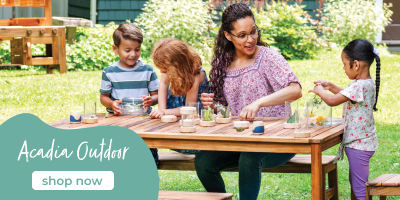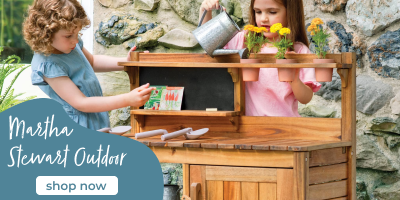5 Benefits of Dress-Up and Pretend Play

Experts say that pretend play is a natural way for growing children to learn and develop and that parents should encourage this type of imaginative expression. Whether it’s with a pair of fairy wings, a doctor’s stethoscope, a sparkly scarf or a silly hat, children live out their creative fantasies during dramatic playtime.
We all remember playing dress up. Maybe we borrowed our mothers’ high-heeled shoes and clopped around the kitchen; maybe we took our grandfathers’ jackets and used them as superhero capes. Dress up is a natural method of play that allows children to live out their creative fantasies, be they full of sailing pirate ships or baking cookies. While children can turn almost any article of clothing into a grand costume, dress-up kits like Guidecraft’s line of dress up centers and vanities make pretend play even easier and help build important academic skills, from mathematical thinking to physical coordination.

Pretend play is a fun, natural way for children to learn and develop their growing minds. In Planning for Play: Building the Young Brain through Creative Expression, Gryphon House author Kristen M. Kemple outlines five key areas of a child’s early development that benefit from dress-up and pretend play:
1. Boost early brain development
During the first few years of life, children’s brains are developing at an incredibly fast rate. This is because their synapses are constantly firing to create neural pathways. These pathways are mental connections between two bits of information, like the color red and the shape of an apple, or the dropping of an object and the loud sound it makes. Dress up and other forms of dramatic play exercise these pathways because they allow children to recreate the circumstances that formed them. A child has noticed that Mommy wears an apron when she cooks; he then mimics that costume and behavior, reinforcing the connection.

2. Improve early cognitive development
Cognitive development refers to a child’s ability to understand abstract concepts and think critically. Like brain development, this is often done through exploration and experience with the world. Many cognitive skills are exercised through play, from basic math as children count the toy eggs in a carton to literacy when they write the day’s specials on a deli board. Costumes make these experiences more real and immersive, reinforcing the real-world application of more-abstract concepts. Dress up also adds an element of planning for the play; the costume becomes a step necessary for the play, encouraging children to think ahead as they set up their games.
3. Enhance children’s social-emotional development
Social-emotional learning is just as important as academic learning. Most children first learn how to interact with others through play, and dramatic-play scenarios provide them with a way to practice how they should treat other people. While dolls and toy animals can reflect how children interact with their peers in daycare, dress up play can add an additional social challenge as children imagine how to act in the adult world. For example, two children are playing hospital, one of them wearing the nurse’s clothes and one of them wearing the doctor’s. The “doctor” is expected to tell the “nurse” what to do. How does each child handle this dynamic? The “doctor” likely will learn how to politely ask people to do things without being unreasonable; meanwhile, the “nurse” will learn how to follow someone else’s directions. The costumes provide an additional layer to their play interaction.
4. Promote children’s language and literacy development
Play provides plenty of opportunities for childrento use their literacy skills. A “waitress” might write down her “customers’” orders, while a “teacher” grades the tests of his “students.” What the children write in these situations is irrelevant; the important part is that they are coming to understand the relationship between written words and the real world. In play, even the most indecipherable scribble means something. Pretend play can also broaden a child’s vocabulary. A child pretending to be a firefighter will use a different word from when she pretends to be a chef. That variety allows children’s knowledge of the world to grow, and encourages their communication to become more precise.
5. Strengthen children’s physical development
Dress up provides a ton of opportunities for motor-skill practice! In addition to encouraging active play—from the fine movement of gripping a spatula to the broader task of kicking a soccer ball—the very nature of costumes requires that children use their motor skills to put them on.
Little learners exercise their fine motor muscles as they attempt to button, zip, or tie on their new clothes, while larger muscles are used to locate arm-holes and shimmy into shirts. Though simple tasks, these small moments of play prep add up to refine children’s movements and give them better control over their bodies.
Pretend play and dress-up is so much more than a way to pass an afternoon. It’s an important piece of childhood play, one with as many benefits as academic instruction!

















